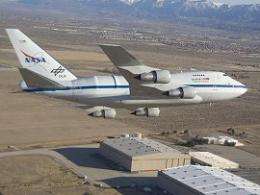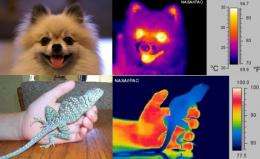SOFIA Seeks Secrets of Planetary Birth

You don't always have to have a rocket to do rocket science. Sometimes a mere airplane will do - that is, a mere Boeing 747 toting a 17-ton, 9-foot wide telescope named SOFIA.
Short for Stratospheric Observatory for Infrared Astronomy, SOFIA will observe the universe while gliding through the stratosphere at 45,000 feet. When it begins operations next year, it will be the world's biggest, most advanced airborne observatory.
"SOFIA is set to achieve some spectacular science," says project scientist Pamela Marcum. "For instance, this telescope will help us figure out how planets form and how our own solar system came to be."
And as a mobile observatory, it can fly anywhere, anytime. SOFIA can move into position to capture especially interesting astronomical events such as stellar occultations (when celestial objects cross in front of background stars), while ground-based telescopes fastened to the "wrong" geographic locations on Earth's surface miss the show. SOFIA will fly above the veil of water vapor that surrounds Earth to take a wide-eyed look at the cosmos.
Although our galaxy teems with planetary systems, astronomers don't know exactly how they form. That's because ordinary telescopes can't see through the giant, dense clouds of gas and dust that spawn planets. Using infrared wavelengths, SOFIA can pierce the haze and watch the birthing process - showing scientists how molecules come together to construct worlds.
"SOFIA will be able to locate the 'planetary snowline,' where water vapor turns to ice in the disk of dust and gas around young stars," says Marcum. "That's important because we think that's where gas giants are born. The most massive planetary cores are fashioned [around the snowline] because conditions are best for rock and ice to build up." (Sticky ice particles help form planets just as they help you make a snowball to hurl at an unsuspecting friend.)
"Once a large enough core forms, its gravity becomes strong enough to hold on to gas so more hydrogen and helium molecules can 'stick.' Then these large cores can grow into gas giants like Jupiter and Saturn. Otherwise, they remain as smaller rock-ice planets."
"SOFIA will also be able to pinpoint where basic building blocks like oxygen, methane, and carbon dioxide2 are located within the protoplanetary disk."
Knowing where various substances are located in the disk will cast light on how they come together, from the "ground" up, to form planets.
One of the telescope's key strengths is its ability to complement other infrared observatories. With a 20-year lifetime, it can do follow up studies on objects shorter-lived infrared scopes don't have time to hone in on. If, for example, an orbiting observatory like WISE spots something deserving of more attention, SOFIA can move in for a long, slow look, while WISE continues gazing at the rest of the sky.
"WISE is designed to scan the entire sky at infrared wavelengths, gathering survey data for multitudes of objects rather than studying targeted objects in great depth," explains Marcum. "But SOFIA has time to spare for deeper studies."

SOFIA can also do follow-up science to reap the full benefits of discoveries from Herschel's deep spatial surveys, and later, the James Webb Space Telescope's near- to mid-infrared investigations.
"Once Herschel runs out of its 3-year supply of coolant, SOFIA will be the only observatory routinely providing coverage within the far-infrared to submillimeter wavelength range. This part of the spectrum is largely unexplored territory."
"And although SOFIA covers the same part of the spectrum James Webb (JWST) covers, SOFIA is optimized for wavelengths just beyond JWST to complement its observations. SOFIA will do a bang-up job observing between the JWST and Herschel wavelength gap."
Unlike these space-based scopes, SOFIA can "head back to the barn" periodically for instruments to be repaired, adjusted, or even swapped out for new and improved science instruments - keeping pace with cutting edge science from a "mere" airplane.
Source: Science@NASA, by Dauna Coulter



















